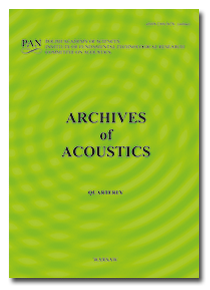10.24425/aoa.2024.148789
Sound Insulation Properties of Sound-Reduction Louvers with Innovative Devulcanized Rubber
References
Bujoreanu C., Nedeff F., Benchea M., Agop M. (2017), Experimental and theoretical considerations on sound absorption performance of waste materials including the effect of backing plates, Applied Acoustics, 119: 88–93, doi: 10.1016/j.apacoust.2016.12.010.
Corredor-Bedoya A.C., Zoppi R.A., Serpa A.L. (2017), Composites of scrap tire rubber particles and adhesive mortar – Noise insulation potential, Cement and Concrete Composites, 82: 45–66, doi: 10.1016/j.cemconcomp.2017.05.007.
Dissanayake D.G.K., Weerasinghe D.U., Thebuwanage L.M., Bandara U.A.A.N. (2021), An environmentally friendly sound insulation material from post-industrial textile waste and natural rubber, Journal of Building Engineering, 33: 101606, doi: 10.1016/j.jobe.2020.101606.
Gandoman M., Kokabi M. (2015), Sound barrier properties of sustainable waste rubber/geopolymer concretes, Iranian Polymer Journal, 24(2): 105–112, doi: 10.1007/s13726-014-0304-1.
Gao N., Hou H. (2017), Low frequency acoustic properties of a honeycomb-silicone rubber acoustic metamaterial, Modern Physics Letters B, 31(11): 1750118, doi: 10.1142/S0217984917501184.
Güneyisi E. (2010), Fresh properties of self-compacting rubberized concrete incorporated with fly ash, Materials and Structures, 43: 1037–1048, doi: 10.1617/s11527-009-9564-1.
Hong Z., Bo L., Guangsu H., Jia H. (2007), A novel composite sound absorber with recycled rubber particles, Journal of Sound and Vibration, 304(1–2): 400–406, doi: 10.1016/j.jsv.2007.02.024.
International Organization for Standardization (1998), Acoustics. Determination of sound absorption coefficient and impedance in impedances tubes. Part 2: Transfer-function method (ISO Standard No. 10534-2:1998), https://www.iso.org/standard/22851.html.
International Organization for Standardization (2010), Acoustics. Determination of sound power levels and sound energy levels of noise sources using sound pressure. Precision methods for reverberation test rooms (ISO Standard No. 3741:2010), https://www.iso.org/standard/52053.html.
International Organization for Standardization (2020), Acoustics. Measurement of insertion loss of ducted silencers without flow. Laboratory survey method (ISO Standard No. 11691:2020), https://www.iso.org/standard/69859.html.
Juliá E., Segura J., Nadal A., Gadea J.M., Crespo J.E. (2013), Study of sound absorption properties of multilayer panels made from ground tyre rubbers, Annals of the Oradea University. Fascicle of Management and Technological Engineering, XXII(XII): 1–13.
Karakurt C. (2015), Microstructure properties of waste tire rubber composites: An overview, Journal of Material Cycles and Waste Management, 17: 422–433, doi: 10.1007/s10163-014-0263-9.
Khaloo A.R., Dehestani M., Rahmatabadi P. (2008), Mechanical properties of concrete containing a high volume of tire-rubber particles, Waste Management, 28(12): 2472–2482, doi: 10.1016/j.wasman.2008.01.015.
Kosała K. (2019), Sound insulation properties of two-layer baffles used in vibroacoustic protection, Applied Acoustics, 156: 297–305, doi: 10.1016/j.apacoust.2019.07.028.
Landi D., Gigli S., Germani M., Marconi M. (2018), Investigating the feasibility of a reuse scenario for textile fibres recovered from end-of-life tyres, Waste Management, 75: 187–204, doi: 10.1016/j.wasman.2018.02.018.
Maderuelo-Sanz R., Nadal-Gisbert A.V., Crespo-Amorós J.E., Parres-García F. (2012), A novel sound absorber with recycled fibers coming from end of life tires (ELTs), Applied Acoustics, 73(4): 402–408, doi: 10.1016/j.apacoust.2011.12.001.
Marriott K. (2012), An update on acoustics designs for HVAC (Engineering), [in:] Proceedings of the Acoustics 2012 Nantes Conference, pp. 3823–3829.
Nacif G.L., Panzera T.H., Strecker K., Christoforo A.L., Paine K. (2013), Investigations on cementitious composites based on rubber particle waste additions, Materials Research, 16(2), doi: 10.1590/S1516-14392012005000177.
Siddique R., Naik T.R. (2004), Properties of concrete containing scrap-tire rubber – An overview, Waste Management, 24(6): 563–569, doi: 10.1016/j.wasman.2004.01.006.
Su H., Yang J., Ling T.C., Ghataora G.S., Dirar S. (2015), Properties of concrete prepared with waste tyre rubber particles of uniform and varying sizes, Journal of Cleaner Production, 91: 288–296, doi: 10.1016/j.jclepro.2014.12.022.
Swift M.J., Briš P., Horoshenkov K.V. (1999), Acoustic absorption in re-cycled rubber granulate, Applied Acoustics, 57(3): 203–212, doi: 10.1016/S0003-682X(98)00061-9.
Viveiros E.B., Gibbs B.M. (2003), An image model for predicting the field performance of acoustic louvres from impulse measurements, Applied Acoustics, 64(7): 713–730, doi: 10.1016/S0003-682X(03)00008-2.
Xu X., Wang H., Sun Y., Han J., Huang R. (2018), Sound absorbing properties of perforated composite panels of recycled rubber, fiberboard sawdust, and high density polyethylene, Journal of Cleaner Production, 187: 215–221, doi: 10.1016/j.jclepro.2018.03.174.
DOI: 10.24425/aoa.2024.148789






